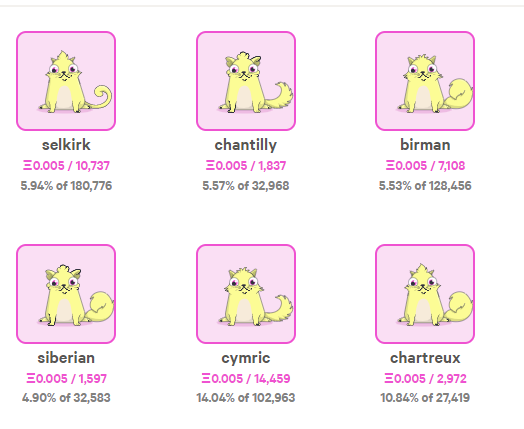What Are the Token Standards for NFT?
The well-known ERC-20 protocol is an earlier token standard in the Ethereum blockchain, and it is the protocol standard for fungible tokens. Up to now, most of the non-fungible tokens(NFT) are issued on the Ethereum blockchain, the mainstream standards are:
- ERC-721: This is the earliest standard for NFT, each token required a separate smart contract
- ERC-1155: It was pioneered by the team of Enjin Company and proposed a semi-fungible scheme for NFT. ERC-1155 allows for more efficient trades and bundling of transactions – thus saving costs. Such contracts can contain both fungible and non-fungible tokens.
- ERC-998: It is also called composable non-fungible tokens standard. ERC-998 is an extension of the ERC-721. It is composable that allows people to combine a group of ERC-20 tokens or ERC-721 tokens or even both. For example, in a block game, ownership of a game character represents one NFT, while ownership of character equipment represents another NFT. ERC-998 allows users to combine the NFTs into one NFT.
Note: In addition to Ethereum, there are also NFT standards for NEO, EOS, TRON, FLOW, Binance, and COSMOS blockchains. The standardization of NFTs is crucial, especially in terms of interoperability, which allows NFTs to be transferred between different Dapps.
In the following part, we will introduce the mainstream standards details:
What Is ERC-721?
The ERC-721 introduces a standard for NFT. ERC-721 has similar properties to ERC-20. The similarity between the two is that digital asset information is kept on the same blockchain. The key difference is that ERC-721 allows tracking of ownership records for assets that have unique characteristics, this type of Token is unique and can have a different value than another Token from the same Smart Contract, which may be due to its age, rarity, or even something else like its visual. All NFTs have a uint256 variable called tokenId, so for any ERC-721 Contract, the pair contract address, uint256 tokenId must be globally unique. That said, a dApp can have a "converter" that uses the tokenId as input and outputs an image of something cool, like zombies, weapons, skills, etc.
Compared with ERC-20, the ERC-721 has more functions and more advanced technology. The protocol is Ethereum's first standard for NFT digital assets and it is used in projects such as CryptoKitties and Decentraland. The ERC721 standard was created and published by Dieter Shirley, CTO of CryptoKitties, who can be said to be one of the founders of NFTs.
The advantage of ERC-721 is that assets (paintings, bonds, houses or cars, etc.) under the ERC-721 standard can ensure the security of ownership, ease of transfer, and immutability and transparency of ownership history. Now the ERC-721 standard is also widely used in the blockchain game and Metaverse virtual assets.

What is ERC-1155 and How does ERC-1155 work?
ERC-1155 is a standard interface for contracts that manage multiple token types. A single deployed contract may include any combination of fungible tokens, non-fungible tokens, or other configurations. (e.g. semi-fungible tokens).
ERC-1155 token can do the same functions as an ERC-20 and ERC-721 token, and even both at the same time. And best of all, improving the functionality of both standards, making them more efficient, and correcting obvious implementation errors on the ERC-20 and ERC-721 standards. The use case can be the game. For example, there is a game with 100,000 daily active users and one million registered users. Everyone who upgrades the game gets a sword. At this time, it will cost millions of gas fees to transfer the NFT sword to one million people on the blockchain. The process is cumbersome and the time period is relatively short. long. The birth of ERC1155 can solve these similar problems to a certain extent, because this protocol standard has both the characteristics of NFT and FT, and has the characteristics of semi-fungible tokens. Compared to ERC721, ERC1155 stand for NFT is no longer an item, but a category (Class). For example, in the game upgrade mentioned above, each user sends A sword, that's a category. The collection of game items is a category, and the quantity of the sword is set when transferring tokens so that you can send multiple quantities of items only by deploying the contract once.
Moreover, the great feature of ERC-1155 is its cross-chain compatibility, compare to ERC-20 and other standards. So far, most of a user's assets can only be available on the Ethereum blockchain, however, the ERC-1155 standard also makes their assets compatible with other ecosystems.
ERC-1155 is very different from traditional tokens' standards and cannot be destroyed directly. Instead, they usually remain in circulation unless the original developer regularly buys them back. ERC-1155 is positioned as a more specific token standard in that any asset can be created and destroyed at any given time.
The benefit is the token scarcity. In the ERC-20 protocol, scarcity is almost non-existent. Under the ERC-1155 protocol, the destruction of assets can reduce circulation, improve the overall scarcity, and provide a different type of token protocol than traditional options.

What Is ERC-998?
ERC-998 can create composable and synthesizable NFTs (Composable NFTs, abbreviated as CNFTs). It is designed so that any NFT can contain other NFTs or FTs. When you transfer CNFT, you are transferring the entire hierarchy and affiliation that CNFT has. Simply put, an ERC-998 item can contain multiple ERC-721 and ERC-20 items.
As mentioned above, in blockchain games, the ownership of a game character represents a non-fungible token, and the ownership of character equipment represents another token. Although character equipment belongs to the character, this affiliation cannot be reflected under the existing ERC-721 system; if you want to trade, only the character and the equipment can be traded separately. ERC-998 allows users to synthesize the two into one token. The synthetic parent token contains the ownership relationship of the two-child tokens of characters and equipment, so as to make it easier to package and sell, and greatly simplify the transfer of items.
Comments
Post a Comment